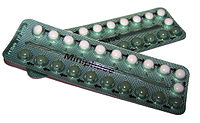
Photo from wikipedia
The aim of this study was to evaluate and compare the reparative and inhibitory effects of single wavelength photobiomodulation (SW-PBM) and of cumulative increased wavelength photobiomodulation (CW-PBM) on orthodontically induced… Click to show full abstract
The aim of this study was to evaluate and compare the reparative and inhibitory effects of single wavelength photobiomodulation (SW-PBM) and of cumulative increased wavelength photobiomodulation (CW-PBM) on orthodontically induced inflammatory root resorption (OIIRR). Thirty-three Wistar albino rats were divided into five groups: untreated group (negative control), only relapse group (positive control-1), only retention group (positive control-2), SW-PBM group (650 nm, 100 mW/cm 2 ), and CW-PBM group (532–650–940 nm, 100 mW/cm 2 ). Orthodontic tooth movement was induced experimentally in rats for 10 days with an applied force of 50 cN; retention and therapeutic approaches were performed concurrently. At the end of the experiment, maxillary quadrants were prepared for micro-CT analysis and real-time polymerase chain reaction (RT-PCR) analysis. After the Shapiro-Wilk normality test, Kruskal-Wallis test followed post hoc Bonferroni test and paired samples t test was used for statistical evaluation of the data. Resorption lacunae volume ( p < 0.001), number of resorption lacunae ( p < 0.05), and percentage of the resorption (PR) lacunae ( p < 0.001) decreased with PBM applications when compared with the positive control groups, and the mean PR was similar in the negative control group when compared with SW-PBM group. Receptor activator of nuclear factor kappa B ligand (RANKL) levels of the PBM groups were lower ( p < 0.05) than those of the positive control groups. Cyclooxygenase-2 (COX-2) expression levels significantly decreased with PBM administration ( p < 0.05). No significant change was found in osteoprotegerin (OPG) expression levels and OPG/RANKL ratios ( p > 0.05). PBM applications showed marked inhibitory and reparative effects on OIIRR by modulating the RANKL and COX-2 expression levels. However, the effects of the different wavelengths were similar to each other. Graphical abstract
Journal Title: Lasers in Medical Science
Year Published: 2020
Link to full text (if available)
Share on Social Media: Sign Up to like & get
recommendations!